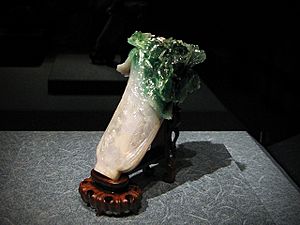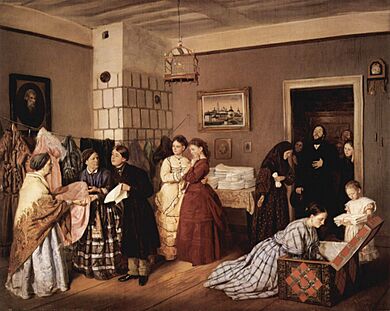Dowry facts for kids
A dowry is a payment, like land, money, or other valuable things, that a bride's family gives to the groom or his family when they get married.
It's different from a bride price, which is when the groom or his family pays the bride's family. It's also different from a dower, which is property the groom gives to the bride, and she keeps it as her own.
Dowry is a very old custom. It's mentioned in some of the earliest writings we have. Today, dowries are still expected in some parts of the world, mostly in Asia. This custom is most common in cultures where families are strongly focused on the father's side, and women are expected to live with or near their husband's family. Dowries have a long history in Europe, South Asia, Africa, and other places.
Contents
History of Dowries
Ancient Times
Babylon
Even in ancient Babylon, the Code of Hammurabi talks about dowries as an old tradition. Daughters usually didn't inherit their father's property directly. Instead, when a woman married, she received a dowry from her parents. This dowry was meant to give her financial security for her whole life.
In Babylon, both bride prices and dowries were common. A wife's dowry was managed by her husband, but it was legally kept separate. It was meant to support the wife and her children. If her husband died, she was entitled to her dowry. If she died without children, her dowry went back to her own family. If she had sons, they would share it.
Ancient Greece
In early Greece, a bride price was usually given. Later, in the 5th century B.C., dowries became common. A husband had some rights over his wife's dowry. However, a wife could also bring her own property to the marriage that was not part of the dowry. This was called "beyond the dowry" or parapherna.
A dowry could also protect the wife from bad treatment by her husband's family. If she died soon after marrying, the dowry was often returned to her family. This gave the husband a reason to treat her well. In modern Greece, dowries were removed from family law in 1983.
Roman Empire
The Romans also practiced dowry, which they called dos. This was property given by the bride, or someone on her behalf, to the groom or his father at the time of marriage. The dowry helped the husband pay for the costs of married life. Any property the wife had that was not part of the dowry was called Parapherna.
Dowries could include any type of property, given or promised at the wedding. Not just the bride's family, but anyone could donate property as a dowry for a woman. There were different types of dowries depending on who gave them. It was customary for the bride's family to give a dowry based on their wealth.
Dowries Around the World
China

Dowries were common in China throughout history. They were called Jiàzhuāng. A dowry could include land, jewelry, money, clothes, sewing tools, and household items. Many people saw dowry as a way for daughters to receive an inheritance. In traditional China, family property usually went only to sons. So, dowry was the main way assets were transferred to a daughter.
The dowry a woman brought was usually kept separate from her husband's family property. She could sell it for cash if times were hard or to help her children and husband. Sometimes, she might pass her dowry on to her own daughter or daughter-in-law. A woman who brought a large dowry was often seen as more respected in Chinese culture.
Europe
Dowries were widely used in Europe until recent times. The folk tale Cinderella can be seen as a story about the struggle to provide dowries. In the opera La Cenerentola, the stepfather wants to make his own daughters' dowries bigger, which he can't do if he has to provide a third dowry for Cinderella.
Sometimes, if an unmarried woman was kidnapped, the kidnapper had to provide her dowry as a punishment. This was sometimes called "wreath money."

Giving dowries to poor women was seen as an act of kindness by wealthy people. The custom of Christmas stockings comes from a legend about St. Nicholas. He supposedly threw gold into the stockings of three poor sisters to provide their dowries. In 1425, the city of Florence created a public fund to help provide dowries for brides.
Large inheritances were common as dowries for royal brides in Europe during the Middle Ages. For example, in 1661, the Portuguese crown gave two cities in India and Morocco as a dowry to the British Crown when King Charles II of England married Catherine of Braganza, a Portuguese princess.
In some cases, nuns had to bring a dowry when joining a convent. In places like old France, convents were sometimes used by parents to place daughters whose families couldn't provide a marriage dowry.
In some parts of Germany, parents who had no sons might give land as a dowry to their new son-in-law. This often came with the condition that he take his bride's last name to continue the family name.
England
Dowry was used in England, but it was different from other parts of Europe. In England, daughters had the right to inherit, and women could own property in their own name. This was not always the case in other countries. For example, Elizabeth I of England had all the rights a male ruler would have.
After the Norman Conquest in the 12th century, laws changed for married women. A system called Coverture meant that a wife's property was often held in her husband's name and under his control. The Normans also brought the dowry custom to England, replacing an older custom where the husband gave a "morning gift" to his bride.
If the husband died first, which was common, the widow received a "Widows dowry." This was one-third of her husband's land at the time of their marriage. She would receive the income from this land for the rest of her life. This idea was even included in the Great Charter.
Court records from the 13th century show many arguments over dowries, and the laws became very complicated. The English dowry system allowed most noble families to marry off their daughters, which helped them gain new family connections.
If a dowry wasn't provided as agreed, a marriage could be called off. William Shakespeare used this idea in his play King Lear. One of Cordelia's suitors gives up when he hears King Lear won't give her a dowry.
In Victorian England, some wealthy families saw dowries as an early payment of a daughter's inheritance. If a couple died without children, the woman's dowry was often returned to her family. The system of Coverture was eventually ended in the 1800s. This meant that a single woman's property either stayed hers after marriage, or its income became shared property with her husband.
Russia
In some parts of Europe, especially Eastern Europe, giving land as a dowry was common.
The Domostroy, a Russian advice book from the 16th century, suggested setting aside property for a dowry. It advised collecting linens, clothing, and other items for it over time. In later Tsarist Russia, the dowry first included clothes, linen, and bedding for the bride. Later, money was sometimes added, especially if the bride was seen as having some flaw.
The Americas
Indigenous cultures
In some Native American cultures, there was a "reciprocal exchange" of gifts between the bride's and groom's families. Among some tribes of the American Plains, a mix of dower and dowry was used. The groom would give horses to the bride's parents, and they would give a gift to the groom.
Mexico
Spanish settlers brought the dowry custom to Mexico. Spanish laws allowed brides to control their dowry even after marriage. This was different from the usual European practice where the dowry went to the groom's control. In reality, women often kept control over their dowries. Husbands might use dowry funds for investments, but wives also used their dowry money to run their own businesses, like grocery stores or shops. Dowries were common in early colonial times but became less common by the mid-18th century.
New France
The French government tried to encourage marriage for male soldiers and traders in New France (now Quebec). They gave dowries to women who were willing to travel to the colony. These women were known as filles du roi (daughters of the king).
Convents in Quebec, like in Europe, required a dowry from parents whose daughters wanted to become nuns. This rule helped control who could join religious communities. However, girls without a dowry were often supported by generous people, and sometimes convents lowered the required amount.
United States

The custom of dowry was brought to the United States by colonists from England and other parts of Europe. One story tells how John Hull, a wealthy man in Boston, decided his daughter Hannah's dowry. He supposedly put his 18-year-old daughter on one side of a large scale and piled silver shillings on the other side until it matched her weight. That was her dowry!
In the 19th century, daughters of wealthy factory owners sometimes received large "dowries" from their fathers to marry European nobles. These nobles often had titles but not much money. This exchange of a title for wealth helped both the bride and groom gain status. A famous example is the marriage of Consuelo Vanderbilt to Charles Spencer-Churchill, 9th Duke of Marlborough in 1895.
Dowries Today
Dowry is still a common practice in many parts of the world, especially in South Asia and some countries in the Middle East and North Africa. It is most common in places where inheritance laws favor men and where women are expected to live with or near their husband's family.
An interesting exception is Bhutan. In Bhutan, there is no dowry system. Inheritance usually passes through the mother's side of the family. Daughters do not take their father's name at birth or their husband's name when they marry. Women can own businesses and land. Sometimes, a future groom will work in the bride's family's home to earn the right to marry her.
India
In India, dowry is called Dahez in Hindi. In eastern India, it's called Aaunnpot. It is a payment of cash or gifts from the bride's family to the groom's family when an arranged marriage takes place. This can include money, jewelry, electronics, furniture, and other household items to help the new couple set up their home.
In India, dowry can put a lot of financial pressure on the bride's family. Even though there are laws against dowry, like the Dowry Prohibition Act, 1961, it is still a common practice in many areas.
See also
 In Spanish: Dote para niños
In Spanish: Dote para niños



